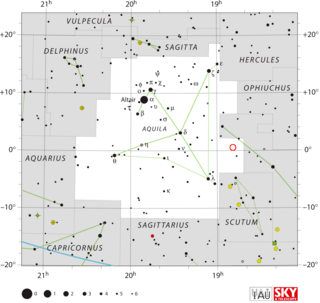
V603 Aquilae was a bright nova first observed in the constellation Aquila in 1918. It was the brightest "new star" to appear in the sky since Kepler's Supernova in 1604. Like all novae, it is a binary system, comprising a white dwarf and donor low-mass star in close orbit to the point of being only semidetached. The white dwarf sucks matter off its companion, which has filled its Roche lobe, onto its accretion disk and surface until the excess material is blown off in a thermonuclear event. This material then forms an expanding shell, which eventually thins out and disappears.
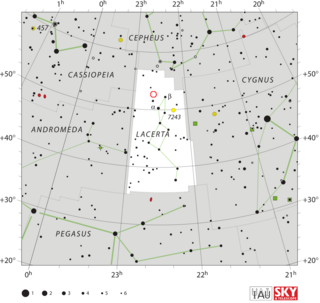
DI Lacertae or Nova Lacertae 1910 was a nova in constellation Lacerta which appeared in 1910. It was discovered by Thomas Henry Espinell Compton Espin at Wolsingham Observatory on 30 Dec 1910, at which time it was an 8th magnitude object. Subsequent examination of pre-discovery photographic plates showed that the outburst occurred sometime between 17 November 1910 and 23 November 1910. It reached a peak brightness of magnitude 4.6 on 26 November 1910, making it visible to the naked eye. Before the nova event DI Lacertae was a 14th magnitude star, and by 1950 it had returned to 14th magnitude.

V533 Herculis was a nova visible to the naked eye, which occurred in 1963 in the constellation of Hercules.
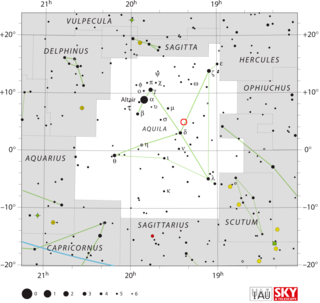
V1494 Aquilae or Nova Aquilae 1999 b was a nova which occurred during 1999 in the constellation Aquila and reached a brightness of magnitude 3.9 on 2 December 1999. making it easily visible to the naked eye. The nova was discovered with 14×100 binoculars by Alfredo Pereira of Cabo da Roca, Portugal at 18:50 UT on 1 December 1999, when it had a visual magnitude of 6.0.

Eta Aquilae is a multiple star in the equatorial constellation of Aquila, the eagle. It was once part of the former constellation Antinous. Its apparent visual magnitude varies between 3.49 and 4.3, making it one of the brighter members of Aquila. Based upon parallax measurements made by the Gaia spacecraft on its third data release (DR3), this star is located at a distance of roughly 272 parsecs. The primary component is a Classical Cepheid variable.
Rho Tucanae is a binary star system in the southern constellation of Tucana. It is visible to the naked eye with a combined apparent visual magnitude of +5.38. Based upon an annual parallax shift of 24.37 mas as seen from Earth, it is located 131 light years from the Sun.

Omicron Andromedae is a star system in the constellation Andromeda. It is approximately 692 light years from Earth. The system as a whole is classified as a blue-white B-type giant, with a mean combined apparent magnitude of +3.62.

Theta Aquilae is a binary star in the constellation Aquila. The combined apparent visual magnitude of the pair is 3.26, making it the fourth-brightest member of the constellation. In Chinese, it has the traditional name Tseen Foo, from the Chinese 天桴, which could mean "heavenly raft" or "heavenly ridgepole"; it might also mean "heavenly drumsticks", with Altair, Beta Aquilae and Gamma Aquilae being the drum. This distance to this star can be determined through the parallax technique, yielding an estimate of roughly 286 light-years from Earth.

Delta Aquilae, Latinized from δ Aquilae, is a binary star system in the equatorial constellation of Aquila. It has an apparent visual magnitude of 3.4 and, based upon parallax measurements, is located at a distance of about 50.6 light-years from Earth. It is drifting closer with a radial velocity of −30 km/s. The system is predicted to come to within 25.4 ly (7.8 pc) of the Sun in around 335,000 years.

18 Aquilae is a triple star system in the constellation of Aquila. 18 Aquilae is the Flamsteed designation; it also bears the variable star designation Y Aquilae. It has an apparent visual magnitude of 5.07, making it bright enough to be seen with the naked eye. The distance to this system can be estimated from the annual parallax shift of 6.43 mas, yielding a value of around 510 light-years away from Earth.
4 Aquarii is a binary star system in the constellation Aquarius, located approximately 198 light years away from the Sun. 4 Aquarii is the Flamsteed designation. It is visible to the naked eye as a dim, yellow-white hued star with a combined apparent visual magnitude of 5.99. The system is moving closer to the Earth with a heliocentric radial velocity of −21.5 km/s.
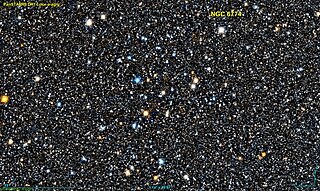
Ruprecht 147 or NGC 6774 is a dispersed star cluster in the Milky Way galaxy. It is about 1,000 light years away, which is close to Earth in comparison with other such clusters. In late summer, it can be seen with binoculars in the constellation of Sagittarius. The stars, bound by gravity, are about 2.5 to 3.25 billion years old.
Kepler-84 is a Sun-like star 3,339 light-years from the Sun. It is a G-type star. The stellar radius measurement has a large uncertainty of 48% as in 2017, complicating the modelling of the star. The Kepler-84 star has two suspected stellar companions. Four red dwarfs are few arcseconds away and at least one is probably gravitationally bound to Kepler-84. Another is a yellow star of mass 0.855M☉ on projected separations of 0.18±0.05″ or 0.26″.
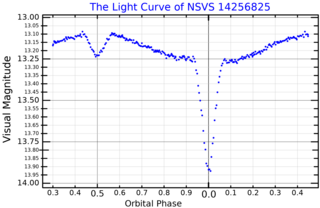
NSVS 14256825, also known as V1828 Aquilae, is an eclipsing binary system in the constellation of Aquila. The system comprises a subdwarf OB star and red dwarf star. The two stars orbit each other every 2.648976 hours. Based on the stellar parallax of the system, observed by Gaia, the system is located approximately 2,700 light-years away.
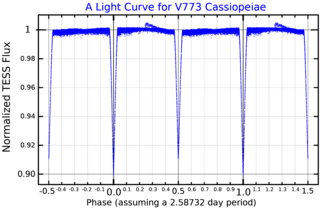
ADS 1359 is a quadruple star system in the constellation Cassiopeia. It is composed of two sun like stars in an eclipsing binary with a 2.5-day period, which is in turn orbited by an A-type main-sequence star with a 185-year orbital period. There is also HD 236848 which is a distant proper motion companion.
34 Pegasi is a triple star system in the northern constellation of Pegasus. It has a yellow-white hue and is dimly visible to the naked eye with an apparent visual magnitude of 5.76. The system is located at a distance of 131 light years from the Sun based on parallax, but is drifting closer with a radial velocity of −13.5 km/s. It has been catalogued as a member of the Hyades Supercluster, although its membership status remains doubtful.

Kepler-560b, or more correctly Kepler-560 Bb, is a confirmed exoplanet orbiting the secondary star of the binary star system Kepler-560. It is only 287 light-years away. Though not listed in the Habitable Exoplanets Catalog, one study gives the planet an 85% chance of being in the habitable zone.
HD 197037 is a binary star system. Its primary or visible star, HD 197037 A, is a F-type main-sequence star. Its surface temperature is 6150±34 K. HD 197037 A is depleted in heavy elements compared to the Sun, with a metallicity Fe/H index of −0.16±0.03, but is younger at an age of 3.408±0.924 billion years.
HD 106315, or K2-109, is a single star with a pair of close-orbiting exoplanets, located in the constellation of Virgo. Based on parallax measurements, this system lies at a distance of 356 light years from the Sun. At that range, the star is too faint to be seen with the naked eye, as it has an apparent visual magnitude of 8.95. But it is slowly drifting closer with a radial velocity of −3 km/s. As of 2020, multiplicity surveys have not detected any stellar companions to HD 106315.











